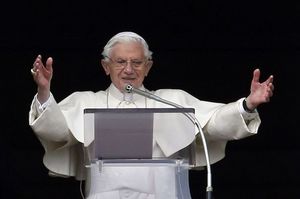This is Pope Benedict’s final Angelus address as the Supreme Pontiff of the one, holy, catholic and apostolic Church. Notice the imagery he uses: the climbing the mountain and “once you’ve met Christ, why come down to pain?” The Pope has a new vocation: to live in adoration of Christ.
On the second Sunday of Lent, the liturgy always presents us with the Gospel of the Transfiguration of the Lord. The evangelist Luke places particular emphasis on the fact that Jesus was transfigured as he prayed: his is a profound experience of relationship with the Father during a sort of spiritual retreat that Jesus lives on a high mountain in the company of Peter, James and John , the three disciples always present in moments of divine manifestation of the Master (Luke 5:10, 8.51, 9.28).
The Lord, who shortly before had foretold his death and resurrection (9:22), offers his disciples a foretaste of his glory. And even in the Transfiguration, as in baptism, we hear the voice of the Heavenly Father, “This is my Son, the Chosen One listen to him” (9:35). The presence of Moses and Elijah, representing the Law and the Prophets of the Old Covenant, it is highly significant: the whole history of the Alliance is focused on Him, the Christ, who accomplishes a new “exodus” (9:31) , not to the promised land as in the time of Moses, but to Heaven. Peter’s words: “Master, it is good that we are here” (9.33) represents the impossible attempt to stop this mystical experience. St. Augustine says: “[Peter] … on the mountain … had Christ as the food of the soul. Why should he come down to return to the labors and pains, while up there he was full of feelings of holy love for God that inspired in him a holy conduct? “(Sermon 78.3).
We can draw a very important lesson from meditating on this passage of the Gospel. First, the primacy of prayer, without which all the work of the apostolate and of charity is reduced to activism. In Lent we learn to give proper time to prayer, both personal and communal, which gives breath to our spiritual life. In addition, to pray is not to isolate oneself from the world and its contradictions, as Peter wanted on Tabor, instead prayer leads us back to the path, to action. “The Christian life – I wrote in my Message for Lent – consists in continuously scaling the mountain to meet God and then coming back down, bearing the love and strength drawn from him, so as to serve our brothers and sisters with God’s own love “(n. 3).
Dear brothers and sisters, I feel that this Word of God is particularly directed at me, at this point in my life. The Lord is calling me to “climb the mountain”, to devote myself even more to prayer and meditation. But this does not mean abandoning the Church, indeed, if God is asking me to do this it is so that I can continue to serve the Church with the same dedication and the same love with which I have done thus far, but in a way that is better suited to my age and my strength. Let us invoke the intercession of the Virgin Mary: may she always help us all to follow the Lord Jesus in prayer and works of charity.
I offer a warm greeting to all the English-speaking visitors present for this Angelus prayer, especially the Schola Cantorum of the London Oratory School. I thank everyone for the many expressions of gratitude, affection and closeness in prayer which I have received in these days. As we continue our Lenten journey towards Easter, may we keep our eyes fixed on Jesus the Redeemer, whose glory was revealed on the mount of the Transfiguration. Upon all of you I invoke God’s abundant blessings!

